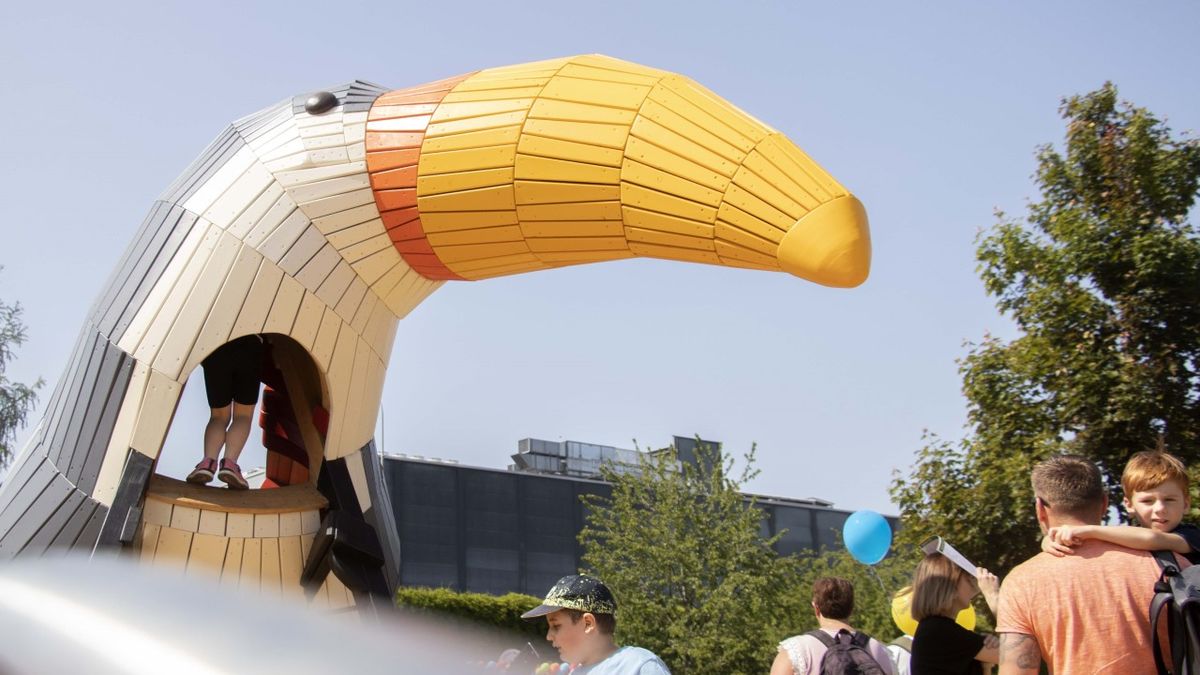Before we go to elmberk itself, we will head to Mladá Vožica. Once there, we are treated to views of the wooded hills, where the beautiful chapel of the Assumption of the Virgin Mary stands.
However, first we started the Mladá Vožice tour at ižka Square, where the local castle stands. Although not accessible to the public, it is one of Mladá Vožice’s landmarks, which is why we didn’t pass by without realizing it.
It was built between 1570 and 1603 for Michal Panovsk of Lisov, the highest clerk of the Kingdom of Bohemia. Then, in 1603, it was bought by Jan Bernhart Fünfkirchen, but his property was confiscated for rebelling against the emperor. It was then handed over to the imperial general don Baltazar de Marradas.
Mladá Vožica is dominated by the castle, which, however, is inaccessible.
Photo: Tereza Havlíčková
Castles serve, among other things, as an economic backdrop, malt house or brewery. In 1629, Veronika Přehořovská of Dlouhá Ves bought it from the general, after which the castle was acquired by František Ferdinand Küenburg, who founded the library here. It was removed from the premises in 1947. Under the Küenburg family, the original Renaissance castle was also rebuilt into its current Baroque form. After World War II, the KOH-I-NOOR company was even located here.
The oldest building is the bell tower
In the square, close to the castle, we find the church of St. Martin, built in 1794 on the site of the original church. On the wall in the foreground of the church, we are attracted by the commemorative plaque with Hebrew inscriptions and a Jewish star as a reminder of September 2, 1942, when 99 residents of Mladá Vožica were dragged to death in the gas chambers. On the left side of the church, we can see the open alcove chapel of St. John of Nepomuk.
Church of St. Martin at Mladá Vožica
Photo: Tereza Havlíčková
The flimsy building nearby, which is the local bell tower, won’t go unnoticed either. The tower was built after the demolition of the royal castle (1425) and is one of the oldest buildings in Mladá Vožice. With the demolition of the castle, the city lost checkpoints from which residents could be warned of possible dangers, especially fire. That was why this tower-like structure — the ballot box — was built in the center of the city.
Salt is stored on the ground floor, the council and prison rooms are used upstairs, and a room for fire safety guards is located upstairs. After the collapse of the local bell tower, the bell was placed on the highest part of the tower.
Chapel of the Assumption of the Virgin Mary
Photo: Tereza Havlíčková
The ground floor later served as a fire station until 1953, and today the space is used as a garage for the neighboring city office. The coat of arms of Mladávožice hangs above the entrance.
A chapel stands on the site of the former castle
We’ll circle the bell tower and continue past the vicarage and elementary school, where tourist signs direct us to the hill called the Castle, where the Way of the Cross begins to the Chapel of the Assumption of the Virgin Mary. This chapel is located where the royal castle once stood, as evidenced by the stone remains of the castle.
The hunting lodge was built around 1840.
Photo: Tereza Havlíčková
It was built in 1646 by Kryštof Karel Přehořovský of Kvasejovice, owner of the Vožice estate at the time. The top itself is accessed by a stone staircase. There are good views from the hills, but the dense vegetation spoils it a bit. Behind the chapel there is also a smaller viewpoint called Paraplíčko, from which we can see the Podhradní rybník.
Here you will find a pottery kiln…
Photo: Tereza Havlíčková
…, but also bread.
Photo: Tereza Havlíčková
The dominant feature of Mladovožick is of course the ruins of the elmberk castle, behind which we will follow the red marker to the hill less than three kilometers from the city. We will start the tour at a nearby hunting lodge. It was built around 1840 as the administrative center of the forest of the aforementioned Küenburg family, who lived in Mladovožice castle. After the war, the building housed, for example, a museum.
We were then able to see the information board at the hunting lodge, which gave us information about the medieval herb garden that stretches around it.
To our surprise, the ruins weren’t the only attraction. The castle is part of a historical craft education center and various “workshops” are held here throughout the year. The area is owned by the city, and the restoration is overseen by an organization, thanks to which we can see, for example, bread and pottery ovens, firing ranges or workshops in the area itself. A weaving workshop, paper mill and brewery are also planned for the future.
The tower becomes an observation tower
elmberk is first mentioned in documents in 1318 and is associated with the Bohemian family of Buzice, which is decorated with a coat of arms with the head of a black boar in a gold field. Then the local branch of the family took the name “from elmberk”. During the Hussite Wars, the castle was damaged and its owners changed frequently. The original Gothic castle was rebuilt in the late 16th century and equipped with new walls, but it didn’t take long and during the Thirty Years’ War it was abandoned and began to deteriorate.
The ruins are freely accessible.
Photo: Tereza Havlíčková
At the end of the 18th century, the 26-meter-high tower was turned into a lookout tower, and in the 1820s, a romantic fortress was added to it. In 1963, the building was registered as a protected cultural monument.
Apart from the tower, only the foundation with the dungeon, the ruins of the Renaissance channel, and the perimeter wall with pillars survive the castle. It is said that on the ground floor of the tower there used to be a dark hunger room, where the rulers mainly threw local slaves, but the reflections of later experts tended to the opinion that these spaces served a different purpose.
On the ground floor, there used to be a hunger room for claws.
Photo: Tereza Havlíčková
Castle ruins are of the bergfrit type, which are usually smaller noble castles made up of basic castle elements (bergfrit, walls, and castle).
The Bergfrit is actually the circular main tower of the castle visible to us, serving the defenders as their last refuge if needed. It used to be only accessible via an easily removable bridge, which was located on a higher floor. Other castles of this type are, for example, Zvíkov or Křivoklát.
The ruins are freely accessible. However, the entrances to the towers and courtyards of the complex are usually closed. You can only go inside during official opening hours (April–October: Saturdays, Sundays, and public holidays 10:00–17:00).
| Free tourist navigation |
| On the go, with tourist navigation mapy.cz. This app is free and works even without signal. |

“Unapologetic social media guru. General reader. Incurable pop culture specialist.”





